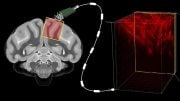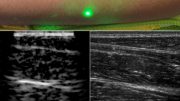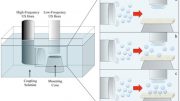
Remote, brain region-specific control of choice behavior with ultrasonic waves.
Noninvasive pulses of ultrasound waves aimed at specific regions in the brains of macaque monkeys can give some control over the monkeys’ choices, scientists report. These findings indicate that ultrasonic brain stimulation could provide a noninvasive, drug-free avenue to study and potentially treat decision-making disorders such as addiction.
Previous research has shown that low-intensity ultrasound waves applied to rodent brains from outside the head can stimulate neurons — including deep, compacted neurons — and cause corresponding muscle movements elsewhere in the body. However, more recent studies have yielded less definitive results, suggesting the technique may have little or no effect. Moreover, effects on behavior in larger animals and humans have not been well studied.
Jan Kubanek and colleagues had two macaque monkeys engage in an experiment widely used to investigate choice behaviors: the monkeys looked at a target at the center of the screen and were then presented with targets on the left and right sides of the screen, one shortly after the other. Monkeys usually choose to look at the target that appears first.
However, by briefly applying ultrasonic waves to the monkeys’ frontal eye fields (FEF), brain regions that control eye movement, the researchers influenced which target the monkey looked at. When the researchers targeted the left FEF, the monkeys were more likely to choose the right target, and vice versa. No effects were observed when ultrasound was applied to the motor cortex, which is not involved in perceptual decision-making.
The scientists rewarded the monkeys differently for the task. Monkey A was rewarded with juice for selecting either target whereas monkey B was only rewarded for selecting the first target. That the researchers controlled the monkeys’ choices regardless of the reward suggests that this technique could be used to study disorders such as addiction, binge eating, and compulsive behaviors.
The authors note the study provides several recommendations for future applications of ultrasonic neuromodulation in animals and humans, including avoiding anesthesia and applying stimulation relatively infrequently, as repetition appears to diminish the effects.
Reference: “Remote, brain region–specific control of choice behavior with ultrasonic waves” by Jan Kubanek, Julian Brown, Patrick Ye, Kim Butts Pauly, Tirin Moore and William Newsome, 20 May 2020, Science Advances.
DOI: 10.1126/sciadv.aaz4193









So, is this another confirmation that everything happens in the brain?
Didn’t US Government have people who were in the Embassy in Cuba have Brain damage from Ultra Sonic wave ? Those people have permanent Brain Damage. Tell me why are we studying Ultra Sonic ?